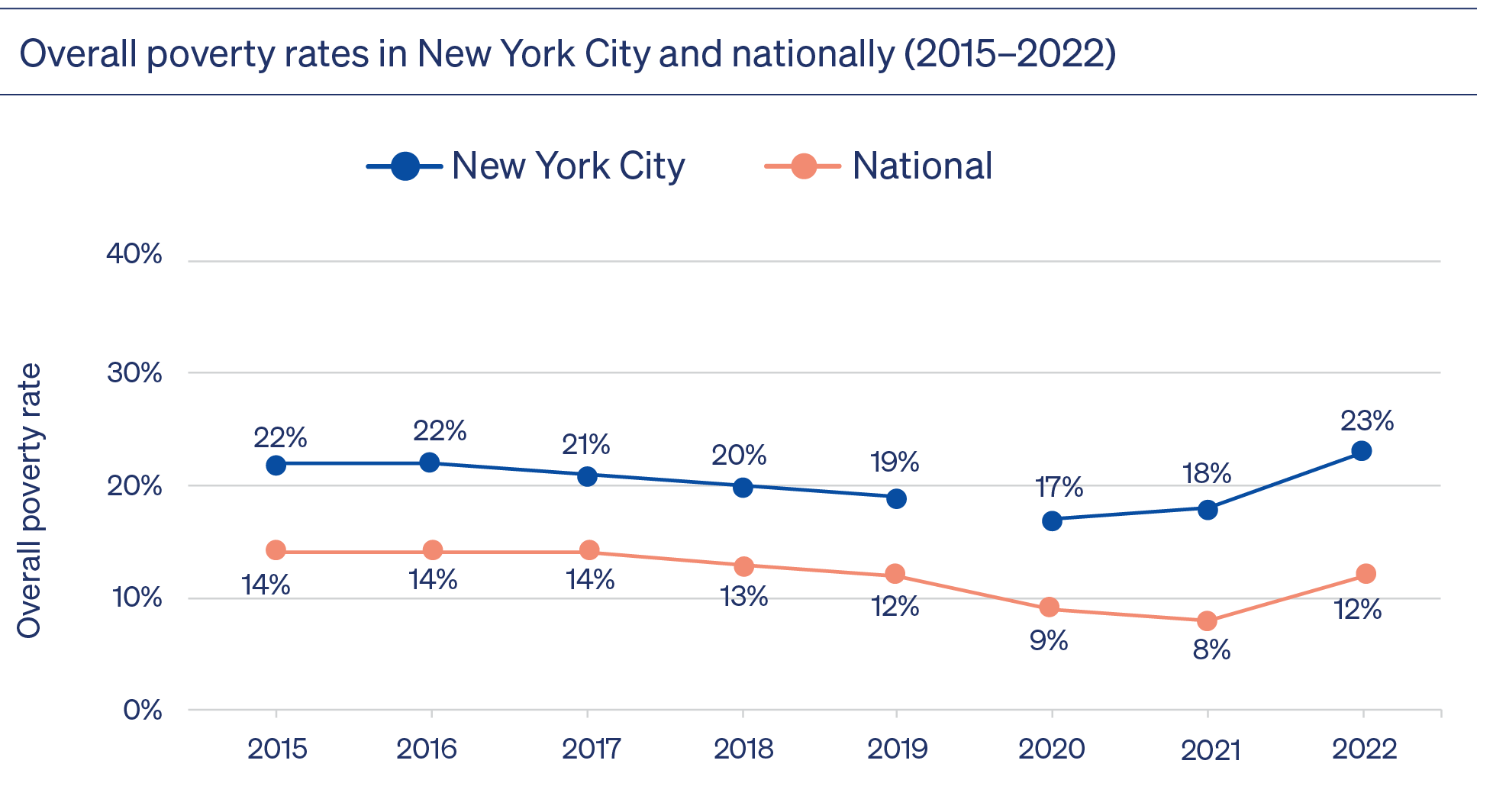February 2024
Annual Report: The State of Poverty and Disadvantage in New York City Vol. 6
This year’s report documents the largest year-over-year increase in poverty since we began conducting the study in 2012. The overall poverty rate in the city increased from 18% in 2021 to 23% in 2022.
Contributors: Christian Baclao, Chantal Bannerman, Lily Bushman-Copp, Yiteng Cao, Chloé Cargill, Daniel Castillo, Alex Centeno, Eunho Cha, Sophie Collyer, Lolita Colon, Natalia Espinoza, Jose Fernandez Vargas, Qin Gao, Irwin Garfinkel, Alyssa Guerrero, Zachary Herzog, Sonia Huq, Yajun Jia, Anastasia Koutavas, Helen Leon, Jessica Liou, Xiaofang Liu, Morgan Lyons, Jessica McTeer, Angie Moran, Max Moran, Kathryn Neckerman, Tien Nguyen, Hailey Osborne, Pelumi Osinubi, Camilo Rincon, Gerardo de la Rosa, Annie Rose, Angelina Ross, Schuyler Ross, Daniel Salgado, Amber Shen, Julien Teitler, Ryan Vinh, Jane Waldfogel, Kahlen Washington, Christopher Wimer, Ho Yan Wong, Jieying Wu, Anke Yan, Christopher Yera
Issues Areas: Annual Report
In 2022, New York City welcomed some changes to everyday life as restrictions associated with the pandemic eased and economic activity began picking up again. The city’s “return to normal,” however, was not without its difficulties, especially for low-income New Yorkers. The year also saw the sunsetting of pandemic-era policy reforms and income supports. These policy shifts, coupled with soaring rent prices and historically high levels of inflation, made affording the rising prices of basic necessities a challenge for all and impossible for many.
Rents in New York City were among the highest in the country in 2022 and New Yorkers were hit hard by steep increases in the costs of energy, transportation, recreation, and food. Prices rose at the same time as many of the unprecedented policy reforms enacted in response to the pandemic – including stimulus payments, the historic expansion to the Child Tax Credit (CTC), and the eviction moratoria, among others – expired, contributing to rising poverty rates and economic hardships nationwide. For many New Yorkers, the economic precarity brought on by income losses and rising prices was exacerbated, but not new. About 1 in 5 New Yorkers lived below the poverty line before the pandemic, and while rates of poverty and hardship fell in response to pandemic-era policies, these measures of disadvantage returned to their pre-pandemic levels in 2022.

Source: New York City results based on annual Poverty Tracker survey data, second through fifth Poverty Tracker cohorts. National results based on authors’ calculations using the Current Population Survey, retrieved from IPUMS-CPS, University of Minnesota, www.ipums.org. Note: In 2020, the Poverty Tracker sampling design changed to include an oversample of New Yorkers of Chinese descent, including those who speak Mandarin. Thus, pre-2020 results are not directly comparable to results from 2020 to the present, which we signify with a break in the New York City trend line. See Appendix B for additional details.
In this report, the sixth volume of the State of Poverty and Disadvantage in New York City, we use the latest data from the Poverty Tracker to examine how New Yorkers fared in 2022 as they faced the compounding effects of these economic shocks and policy changes. We examine income poverty, material hardship (i.e., chronic or acute inability to make ends meet), and health problems, measuring the prevalence of these forms of economic disadvantage, how they varied across subgroups, and the overlap between them.
Our results show a return to pre-pandemic levels of poverty and hardship in 2022, alongside other continuing challenges: the city’s poverty rate remained well above the national average, and substantial disparities – particularly along racial and ethnic lines – persisted. The report also features a spotlight analysis on the affordability challenges faced by many New Yorkers, including those who are not in poverty. The results demonstrate that economic difficulties persist well above the poverty line, yet also highlight the continued need to support New Yorkers with the most limited resources.
The results presented here, and those we have published over the last year, reemphasize that many New Yorkers are consistently facing economic burdens, which are exacerbated by the absence of income supports provided by federal, state, and local policy.